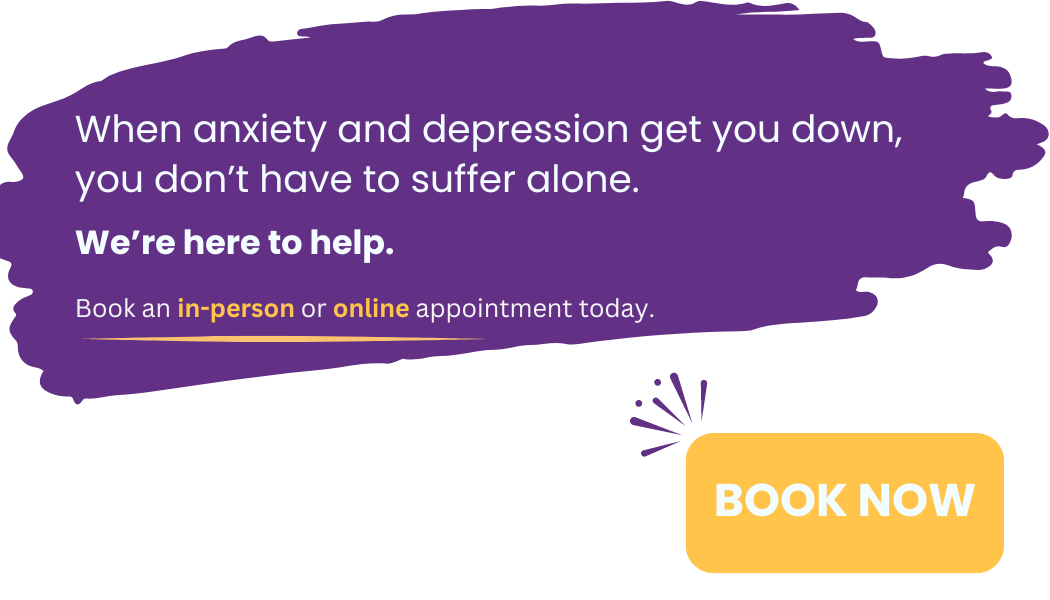Different Types of Therapy for Anxiety and Depression

Anxiety and depression are common yet complex mental health disorders that can significantly impact your quality of life. In the US, at least 31% of adults have experienced anxiety. Another twenty-one million adults have experienced a major depressive episode in their lifetime.
While there are countless therapies to help manage and alleviate your symptoms, it’s difficult to know what will work best for you. Each type of therapy offers unique approaches and techniques that address specific aspects of these disorders. The best way to decide which approach is best for you is to meet with a therapist. By discussing what brings you to therapy and your goals, your therapist will work with you to determine the most appropriate modalities for you.
In this post, we’ll explore many types of therapy, their key principles, and the methodologies of different approaches.
Talk therapy
Counseling or talk therapy is a treatment where you talk to a mental health professional about mental and emotional challenges. By sharing your thoughts, feelings, and experiences in a supportive environment, you can learn how to understand yourself better. Talking with a therapist helps you develop coping strategies for the future.
Therapists use many types of talk therapy, including cognitive behavioral therapy, to help individuals gain perspective on their problems.
Cognitive Behavioral Therapy (CBT)
CBT is one of the most widely used therapies for anxiety and depression. It focuses on identifying and changing negative thought patterns and behaviors that contribute to these disorders. By challenging irrational beliefs and learning healthier coping mechanisms, individuals can reduce symptoms and improve their overall mental well-being.
Dialectical Behavioral Therapy (DBT)
DBT combines cognitive-behavioral techniques with mindfulness practices. Originally designed to treat borderline personality disorder, this therapy has also been applied to other conditions that involve difficulty regulating emotions. These conditions include eating disorders and substance abuse disorders. DBT helps individuals regulate their emotions, improve interpersonal relationships, and develop distress tolerance skills.
What’s the Difference between CBT and DBT?
Both CBT and DBT are evidence-based therapies – meaning their effectiveness is well proven – but they differ in several ways:
1. Focus and Goals
- CBT: Focuses on identifying and changing negative or distorted thinking patterns and behaviors that contribute to emotional distress. It aims to teach coping strategies for managing stressors.
- DBT: This approach is now widely used to treat a variety of psychiatric diagnoses, including anxiety and depression. It focuses on developing skills for managing intense emotions and improving relationships. It focuses on acceptance and change strategies.
2. Structure
- CBT: Typically structured, with a focus on specific problems and goals. Sessions are often time-limited and follow a structured agenda.
- DBT: The sessions have structure but also allow for flexibility. It includes individual therapy, group skills training, phone coaching, and therapist consultation team meetings.
3. Techniques
- CBT: Uses techniques such as cognitive restructuring, behavior modification, and exposure therapy to help individuals change unhelpful thoughts and behaviors.
- DBT: Incorporates techniques from CBT but also includes skills training in areas such as mindfulness, interpersonal effectiveness, emotion regulation, and distress tolerance.
Internal Family Systems (IFS)
Internal Family System (IFS) is based on the premise that individuals have different parts within themselves, each with its own thoughts, feelings, and roles. This therapy aims to help individuals understand and harmonize these parts, reducing internal conflicts and promoting self-compassion.
Trauma-informed Therapy
Trauma-informed therapy recognizes the impact of trauma on mental health. This approach emphasizes safety, trust, empowerment, and collaboration , to help individuals address past traumas and reduce symptoms of anxiety and depression. The goal is to help individuals recognize the role of trauma in their life experiences and begin to heal.
Motivational Interviewing (MI)
Motivational Interviewing (MI) is a collaborative, goal-oriented therapy that focuses on exploring and resolving ambivalence towards change. It helps individuals identify their motivations for change and empowers them to make positive behavioral changes to alleviate anxiety and depression symptoms.
Narrative Therapy
This form of therapy believes that people are separate from their problems. It focuses on the stories they tell about themselves, creating distance between a person and their behavior. This approach values the unique perspectives and experiences of each person.
Exploring these narratives allows individuals to gain insight and create positive change in their lives. And by reauthoring these narratives, individuals can reshape their identities and overcome feelings of anxiety and depression.
Play Therapy
Primarily used for children, play therapy allows them to express their thoughts and feelings through play. It helps children explore and make sense of their experiences, develop coping skills, and improve their emotional well-being.
Movement Therapy
Movement therapy, such as dance therapy or yoga, uses movement to promote emotional, cognitive, physical, and social integration. It can help individuals reduce stress, improve body awareness, and enhance their overall sense of well-being.
Exposure and Response Prevention (ERP)
Exposure and Response Prevention (ERP) is a type of therapy commonly used to treat anxiety disorders, particularly obsessive-compulsive disorder (OCD). It involves gradually exposing individuals to their fears or triggers. The goal is to prevent them from engaging in their usual compulsive responses. Over time, this helps reduce anxiety and break the cycle of obsessions and compulsions.
Solution-Focused Therapy
Solution-focused therapy is future-oriented and focuses on finding solutions rather than dwelling on problems. It helps individuals set achievable goals, identify their strengths, and develop strategies to overcome challenges related to anxiety and depression.
Acceptance and Commitment Therapy (ACT)
Acceptance and Commitment Therapy (ACT) encourages individuals to accept their thoughts and feelings rather than trying to control or eliminate them. It helps individuals clarify their values and take actions aligned with those values. This approach helps people identify their values and make choices that align with them – even in the presence of anxiety and depression symptoms.
How do I choose the right approach for me?
Choosing the right type of therapy depends on many factors. Your concerns, symptoms, preferences, and goals for treatment are among the most important. Educating yourself on different therapy types is a great place to start. Ultimately, your therapist will work with you to select the best therapeutic approach for you.
The next step is to seek professional help. Your counselor will use your therapy sessions to:
- Understand your unique experiences, symptoms, and goals
- Identify an effective treatment plan
- Track your progress
- Develop coping strategies for lasting positive change
What kind of professional should I seek?
Choosing between a psychiatrist, psychologist, therapist or social worker depends on a few key factors. First, consider the type of treatment you’re seeking.
If you’d like to try any of the therapies explored in this post, seek help from a therapist or social worker. Therapists, including psychologists and social workers, provide counseling to help you address emotional, behavioral, or relationship issues.
If you believe medication may help your symptoms, a psychiatrist can help. Psychiatrists are medical doctors who can prescribe medication and often specialize in managing medication for mental health conditions.
Remember, therapy and medication management are not mutually exclusive. Working with a therapist in addition to a psychiatrist is beneficial for comprehensive treatment. Research shows that combining therapy and medication is often more effective than using only one treatment.
This is especially true for severe or long-lasting symptoms. Therapy and medication together can provide better results in these cases. It is important to consider both options when seeking treatment for severe or long-lasting symptoms.
If you struggle with anxiety and depression, there are lots of therapies available to you. By working with a professional, you’ll find the most effective approach to fuel personal growth. Interested in uncovering which path is best for you? Find a therapist today.

